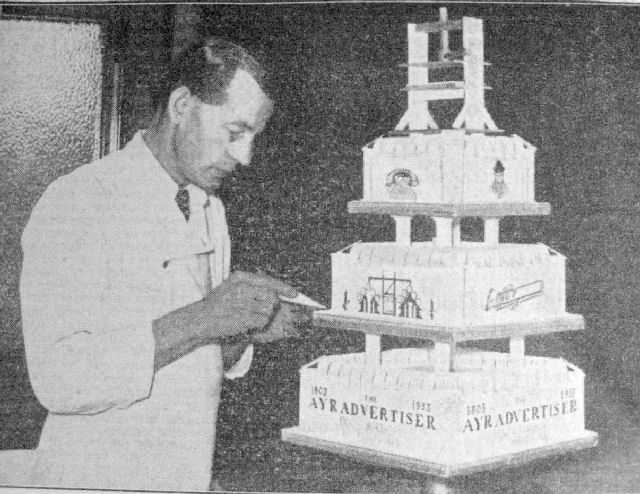 |
The cake for
the 150th anniversaryof the Ayr Advertiser in August
1953. |
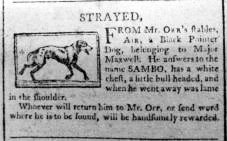 |
Air Advertiser
23rd February 1804 |
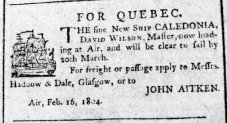 |
Air Advertiser 23rd
February 1804 |
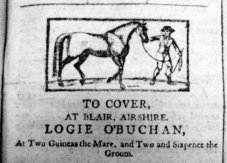 |
Air Advertiser 19th
April 1804 |
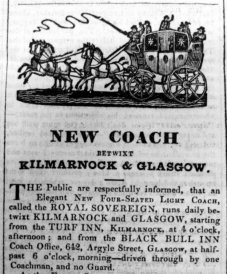 |
Air Advertiser 3rd
November 1825 |
|
On
Thursday 5th August 1803 the first edition of the Air Advertiser
was issued: thus in 2003 we are celebrating the 200th anniversary
of our local newspaper. It is almost impossible to study the history
of Ayrshire over those 200 years and not consult the files of
the Advertiser. It seems appropriate therefore that we
should devote this special issue of Ayrshire Notes to
a history of this venerable and estimable newspaper.1
The Advertiser was the first newspaper to be published
in Ayrshire: Glasgow, Edinburgh and Aberdeen all had regular newspapers
before the end of the 18th Century, but few local papers existed
outside these main centres. One such was the Kelso Mail,
which was founded in 1792.2
Of all the papers in Scotland which preceded the Advertiser,
only the Aberdeen Journal (founded in 1747, and now merged
into the Press & Journal) and the (Glasgow)
Herald, which can trace its ancestry back to 1782, are
still in existence.
The paper was founded by two brothers, John and Peter Wilson.
John Wilson has, of course, won for himself lasting fame and honour
as the printer, in 1786, of Poems, Chiefly in the Scottish
Dialect, the book which brought Robert Burns and his poetry
to national attention and renown. According to contemporary sources,
printing was introduced into Ayrshire in the 1780s, and the first
printer, in Kilmarnock, was Peter McArthur. He, however, must
have ceased business after a short time, and it may be that he
sold his business to John Wilson.3
The earliest book printed by Wilson of which we have any knowledge
is a sermon, Faithful Witness-Bearing Exemplified, of
the mid 17th Century Govan minister Hugh Binning, published in
1783.4
Wilson remained in Kilmarnock, printing books, and also trading
as a bookseller and stationer. Most of his output was of a religious
nature (and thus no different from the output of many a provincial
printer and publisher); however, besides Burns, he also brought
out books of poetry by George Campbell (1787), John Lapraik (1788)
and others, as well as an edition of Milton’s Paradise Lost.
Wilson’s brother Peter was, at the same time, in business as a
bookseller in Ayr. In 1790, because ‘[i]t was, perhaps, more advantageous
to have his printing office in the chief town of the county’,5
John Wilson moved his printing business to Ayr, where he moved
into a closer business relationship with his brother.6
The Wilsons retained a shop in Kilmarnock, but the printing was
now done in Ayr, at 23 High Street, under the supervision of Peter
Wilson. From 1791 books appeared under the imprint of ‘J &
P Wilson’.
In 1803 the brothers undertook their most ambitious project.
Following the example of the Greenock Advertiser, which
had been started in 1802, they produced Ayrshire’s first newspaper,
the Ayr Advertiser, under the supervision of Peter Wilson.7
Thomson also quotes James Gibson, a 19th Century bibliographer
of Burns, who stated that the paper ‘had a hard struggle to maintain
its existence, and was more than once on the eve of being abandoned,
but patience and perseverance overcame all difficulties, and it
ultimately realized a fortune to both brothers.’8
The Wilsons themselves outlined their motives and determination
to succeed in an editorial marking the end of the Advertiser’s
first year:9
At the expiry of the first year of the Air10
Advertiser, which this number completes, the conductors of it
would be wanting in gratitude, were they not to offer their
acknowledgements to their subscribers, and those who have befriended
their undertaking. – Unsolicited by any party, uninfluenced
by any patronage, and only under the conviction that this great
and opulent County ought to possess the circulating medium of
a Newspaper, the proposers of it submitted their plans with
deference and doubt to the Public – The interest of the Public
was what they had resolved to study, and the confidence that
was reposed in their professions, imposed that duty more powerfully
upon them. Situated as Airshire is, at one extremity of the
empire, they could not reckon on their paper finding its way,
except partially, beyond its limits, and where the facilities
of the Posts put it in their power to convey intelligence as
early as their contemporaries. Hitherto they have to congratulate
themselves on a growing circulation through every town in the
County, where the Posts go direct from Air or Kilmarnock.
The expences attending their establishment have far exceeded
their computation; and although they have now a more numerous
list of Subscribers than they originally imagined they could
have had, yet it holds out no immediate prospect of profit:-
However, they are determined to persevere; and if they are fortunate
enough to render their endeavours worthy of the continued countenance
of the Public, an establishment which they have every reason
to think is pretty generally admitted to be useful in the County,
shall not be given up, without the most absolute conviction
that it cannot be supported.
It is unfortunate that no copy of the first issue has survived.
The Wilsons’ own file copy appears to have disappeared early in
the 19th Century, and the earliest issue which remains extant
is number 17, which was published on Thursday, 24th November,
1803. In 1903 it was regretted that ‘[a] few of the earliest numbers
are awanting in our first file. How this came to be, we are unable
to say. We remember hearing long ago a statement to the effect
that after one of the changes in the firm by which the paper was
carried on, it was discovered that the retiring partner had taken
away with him the complete file of the first volume, leaving an
imperfect volume behind.’11
What immediately strikes the modern reader looking at this first
surviving copy of the Advertiser is the nature of the
contents. ‘The Advertiser was a four page folio, about
20 by 14 inches, headed the “Air Advertiser, or West Country Journal”.
… The price was 6d, including 3½d stamp duty. On 7th September
1815 the price was raised to 6½d, following an increase
in Stamp Duty.12 The paper
carried mainly national and foreign news, little local news. The
layout did not change much in the first fifty years of the paper’s
existence. The front page was given over to advertisements and
public notices. The middle pages were devoted to national and
foreign news, while the back page contained more advertisements,
editorial comment and agricultural and local news. Three small
woodblocks were often used to illustrate the advertisements: a
dog for advertisements for lost dogs (a surprisingly frequent
occurrence); a sailing ship for shipping advertisements; and a
horse for advertisements about horses and racing.’13
The advertisements occupy perhaps a third of the paper; they are
mainly local in character and contain much that gives us an insight
into the workings of the world at that time. Farm lets and business
advertisements are the commonest. This November 1803 paper also
carries the notice: ‘We understand a subscription has been started
amongst the noblemen and gentlemen of Ayrshire and neighbouring
counties’ to provide a Gold Cup, to be run for annually on the
first day of Ayr Races.
From 1803 until 1810, the paper continued to be published by
J & P Wilson, but in the latter year, the first changes in
ownership occurred, At the beginning of the year, John Wilson
sold his bookshop in Kilmarnock to Robert Mathie, presumably to
allow himself to concentrate on producing the newspaper, for by
this time, Peter Wilson was seriously ill. In 1810, Peter Wilson
sold his interest in the paper to the Reverend Hamilton Paul,
and the edition for 26th April 1810 appears under the imprint
of ‘Wilson & Paul’: on the back page there is this announcement:-
J Wilson is extremely sorry to announce that for want of health,
his Brother Peter has found it prudent to retire from the Concern,
and that he is thus deprived of the abilities of one, who had
the principal share in commencing and conducting this Paper,
which has every year been extending in circulation, and it is
hoped has been found useful as a medium for advertising, and
as a weekly summary of the Astonishing Events of the present
time.14
Peter Wilson, founder and first editor of the Air Advertiser,
died on 3rd May 1810 at Gibraltar, where he had gone in a
vain attempt to recover his health. His obituary notice declares
that his ‘memory will long be dear to those who have taken an
interest in the success of this paper.’15
With the retirement and death of Peter Wilson, the task of editing
the paper now fell upon Hamilton Paul. Paul was a well-known figure
in his day, but is scarcely remembered at all these days. A clergyman
of the Church of Scotland, he had at this time no parish, and
was able to devote himself to his literary activities. Besides
editing the Advertiser, he was also a poet of some talent,
and was an early proponent of Burns, and wrote one of the earliest
biographies of the Ayrshire Bard. He was poet laureate to the
Burns Club which met annually at Burns’ Cottage, and for 18 successive
years composed an anniversary ode for their dinners: his lament
for the Old Bridge of Doon, published in the Advertiser
at a time when the bridge was earmarked as a quarry for the new
bridge, saved it for posterity.16
He also contributed many articles to the paper, beginning the
tradition of series on various topographical and historical subjects
which add considerably to the value of the paper to modern scholars.
Hamilton Paul was born in Dailly in 1773: his father, John Paul,
was the manager of the collieries on the Bargany Estate. After
studying at Glasgow University, he was licenced to preach in 1800,
and served for some time as the assistant minister at Coylton,
without, it would appear, interfering with his literary and public
interests and ambitions. According to one source, during the time
that he superintended the Advertiser, ‘he was whirled
about in a perpetual vortex of business and pleasure, never a
single day without company at home or abroad. If he could obtain
three or four hours sleep, he was satisfied. He was a member of
every club, chaplain to every society, had a free ticket to every
concert and ball, and was a welcome guest at almost every table.’17
He conducted, according to his obituary, the Advertiser
‘for several years with distinguished success.’18
However, in 1816 Paul was appointed to the living of Broughton,
Glenholm and Kilbucho, in Peebles-shire.19
He sold his share in the business, for £2,500, to McCormick
and Carnie20, and took up
his new living, where he remained until his death in 1854. He
continued, however, to contribute to the Ayr Advertiser,
which for many years carried accounts of the Burns Suppers at
Broughton, and of the activities of the Broughton Curling Club.21
The first issue to appear under the imprint of Wilson, McCormick
and Carnie was that of Thursday 2nd January 1817. The role of
editor was taken on by Adam Carnie;22
the other new partner was William McCormick.23
Under the new firm, the paper continued much as before, though
at this time it had to face its first local competition. The Ayr
and Wigtownshire Courier had been launched by Maxwell Dick
and Alexander Cuthill in 1818, offering a Conservative alternative
to the Whig-supporting Advertiser.24
James Paterson (1805-1876: later the historian of the county)
served his apprenticeship at the Courier, c.1821-1824.25
The Courier survived for approximately seven years, before ceasing
publication about 1825.26
In 1831 James Paterson began publishing his own Radical Kilmarnock
Chronicle, but this was short-lived.27
The next serious challenge to the Advertiser’s position
in Ayrshire came from the Ayr Observer, founded in 1832,
on which more can be found in Appendix 3.[Part 4]
The next major change occurred in May 1821, when John Wilson
died. His obituary is tersely to-the-point:
Died at Wellington Square, here, on Sunday last, Mr. John Wilson,
aged 62. He and his brother, Mr. Peter Wilson, who died in 1810,
were the original projectors and publishers of this Journal,
and their memory will be long cherished by all those who take
an interest in it. Previous to his brother’s death, he was a
Printer in Kilmarnock, and, in the prosecution of his profession
there, he printed the first or Kilmarnock edition of Burns’
Poems and other works of celebrity. He was, likewise, for some
time one of the Magistrates of that place; and throughout a
life rather exceeding in length the ordinary lot of man, he
was distinguished for unremitting attention to the discharge
of a laborious duty, and for the strictest honesty and integrity
both in principle and practice.28
Wilson’s death precipitated a small crisis in the paper. In his
deed of settlement John Wilson had authorised his executors ‘to
dispose of his share of the copy-right or good will of the newspaper,
either by public or private sale’, but to give the chance of first
refusal to McCormick and Carnie, the other partners. They refused
to purchase Wilson’s share and instigated legal proceedings, their
argument being that while Wilson’s executors or heirs might have
a share in the copyright of papers which had already been published,
they could have none in those which were not yet in existence,
and that if a sale were permitted it might bring in a ‘stranger’
who would be ‘detrimental to the interest of the company.’ The
case was decided in the Court of Session, and the decision went
against McCormick and Carnie. The Court laid down that ‘the copyright
or good will of a newspaper is a valuable privilege or property,
transmissible inter vivos, or to heirs; and … like the other rights
of the deceased in the dissolved company, it must be sold for
behoof of his representatives.’ Thomson notes that this was the
first time that it was established in law that newspaper copyright
could be transmitted, by sale or by transfer.29
Top of page
Part 2
Part 3
Part 4
1 I am heavily indebted to
a number of sources. The 100th and 150th anniversaries of the
paper were also occasions for celebratory comment. Hugh Allan’s
article in the Ayr Advertiser of Thursday 6th August
1903, 4efg, has been especially useful. The Ayr Advertiser
of Thursday 6th August 1953 also contains much material,
as well as a number of photographs of the printing works at 100
High Street. Personal communications from Bob Blane and Jim Robb
have helped enormously with the recent past, and I am very grateful
to them for their assistance. Thanks are also due to the staff
of the Carnegie Library, Ayr, and the Baird Institute, Cumnock,
for their help and assistance in the preparation of this article.
Also particularly relevant have been John Ferguson Macnair, ‘Newspapers’,
in Annie I Dunlop, ed., The Royal Burgh of Ayr, Edinburgh,
1953, 279-284, and Carreen S Gardner, Printing in Ayr and
Kilmarnock, Ayr, 1976. The wider picture is less well covered.
William Donaldson, Popular Literature in Victorian Scotland, Aberdeen,
1986, has much interesting material on Scottish newspapers in
the late 19th Century, but its specific examples are mainly from
the north-east.
2 The Kelso Mail ceased
to exist as a separate entity in 1934 when it merged with the
Kelso Chronicle to form the Border Counties &
Kelso Chronicle and Mail. [http://prodigi.bl.uk/nlcat, seen
25th September 2003]
3 McArthur removed to Paisley,
where he was still in business as a printer in 1798. [Scottish
Book Trade Index, www.nls.uk/catalogues/resources/sbti, seen 25th
September 2003]
4 This section on John Wilson
relies heavily on Frances M Thomson, ‘John Wilson, an Ayrshire
printer, publisher and bookseller’, in Bibliotheck, vol 5, no.2
(1967), 41-61.
5 Thomson, ‘John Wilson’,
43.
6 ‘John Wilson, printer’ was
made a Burgess and Guild Brother of Ayr in October 1790; Peter
Wilson was made a Burgess in December 1791, becoming a Guild Brother
in September 1804. [Alistair Lindsay and Jean Kennedy, The
Burgesses and Guild Brethren of Ayr 1647-1846, Ayr, 2002,
187, 188 and 194.]
7 Thomson, ‘John Wilson’,
43. In 1860 James Paterson had in his possession a letter from
Peter Wilson to Hamilton Paul, dated 14th July 1803, regarding
the proposed publication of one of Paul’s sermons, in which Wilson
says: ‘were you to print it, we would like it out of hands before
the 27th [July], when we engage with our paper.’ [See James Paterson,
‘Historical Notes of the Newspaper Press of the County of Ayr’
in Ardrossan and Saltcoats Herald, Saturday 1st December
1860, 2d.]
8 James Gibson, The Bibliography
of Robert Burns, Kilmarnock, 1881, 300.
9 Air Advertiser,
Thursday 26th July 1804, 1a.
10 As we shall see, the
name of the paper was not changed from Air Advertiser to
Ayr Advertiser until 1839.
11 Hugh Logie Allan, ‘Centenary
of the “Ayr Advertiser”’, in Ayr Advertiser, Thursday
6th August 1903, 4e.
12 ‘The Publishers are sorry
to announce to their Readers, that owing to the additional duty
imposed by Government, they are under the disagreeable necessity
of making a small advance on the price of their Journal. From
a principle of gratitude to their respectable Subscribers, they
are solicitous that the pressure should prove as light as possible;
accordingly the proposed rise, as may be seen from the Title,
will be so trifling as to be scarcely felt by any who are desirous
of still honouring with their countenance a Provincial Register
of passing Events, which, for a dozen of years, has been favoured
with an extensive circulation.’ [Air Advertiser, Thursday 7th
September 1815, 4b]
13 Thomson, op cit, 48-49.
14 Air Advertiser, Thursday
26th April 1810, 4a, quoted in Thomson, ‘John Wilson’, 45.
15 Air Advertiser, Thursday
28th June 1810, 4d. The same paper also refers to the recent death
of James Chalmers, who had edited the Aberdeen Journal for
the previous 46 years.
16 John Macintosh, The
Poets of Ayrshire, Dumfries, [1910], 163-4.
17 My thanks to Bobby Logan,
Kilmarnock, for this information.
18 Ayr Advertiser, Thursday
9th March 1854, 4d.
19 It is said, as an example
of his wit, that when Paul was leaving Ayr, he gave a farewell
evening sermon to the young ladies of the town, taking as his
text, ‘And they all wept sore and fell upon Paul’s neck’. (Acts,
xx, 37) (John Macintosh, The Poets of Ayrshire, Dumfries,
[1910], 163) The full verse concludes ‘and kissed him.’
20 Thomson, ‘John Wilson’,
45-46.
21 His obituary, in the
Ayr Advertiser, Thursday, 9th March 1854, 4d, says that ‘few men
in his position in life enjoyed a more extensive acquaintance
than Mr. Paul. Hospitable, kind and charitable to a fault, he
was the friend alike of rich and poor; while the ease of his manner,
the variety and extent of his information, the readiness and point
of his wit, attracted men of taste and learning from all quarters.’
Of Paul’s poetry the obituarist wrote: ‘Volumes might be filled
with selections from Mr. Paul’s poetical compositions. They are
to be found scattered over magazines, reviews, and newspapers,
for upwards of sixty years. He wrote on every kind of subject,
and in every species of measure. His compositions are characterised
by great elegance, but they exhibit versatility of talent and
facility of versification rather than capacity to reach the higher
flights of poetry’, while his sermons ‘were not of the kind calculated
to attract the million. His manner was calm and unimpassioned
– his composition chaste and elegant, and abounding with touches
of great beauty. His sermons exhibited extensive learning and
singular originality of thought; but occasionally his eccentric
genius led him to utter opinions and to support them by illustrations,
however abstractedly correct, which verged upon the ludicrous
and weakened the general effect of his discourse.’ Hamilton Paul’s
sister May was the grandmother of the Kilmarnock poet Marion Paul
Aird (1815-1888) (See Ayrshire Notes, 14, Spring 1998, 8-10, and
ibid, 16, Spring 1999, 4-6.)
22 Adam Carnie, bookbinder,
was made a Burgess of Ayr in December 1815. His father was John
Carnie, tailor. (Lindsay & Kennedy, Burgesses, 200)
23 William McCormick, printer,
was made a Burgess of Ayr in September 1817. The claim was made
through his wife Catherine Gemmell, who was the daughter of Andrew
Gemmell, merchant and burgess. (Lindsay & Kennedy, Burgesses,
200)
24 Maxwell Dick (1798-1870)
was a man of many talents, and is perhaps best known for a variety
of patented inventions, of varying degrees of practical worth.
He had a bookselling business in Irvine, where in the 1820s he
attempted to publish a newspaper, and evade the Stamp Duty, by
publishing under four different titles, each of which appeared
monthly, hence providing a weekly paper. [See James Paterson,
‘Historical Notes of the Newspaper Press of the County of Ayr’
in Ardrossan and Saltcoats Herald, Saturday 1st December
1860, 2e] Alexander Cuthill (c.1786-1852) was the minister of
the Second Charge, Ayr, from 1814. The failure of the Courier
caused Cuthill severe financial embarrassment. He is best known
today for ‘the excellent description of Ayr Parish’ he contributed
to the New Statistical Account. [Ayr Advertiser,
Thursday 19th February 1852, 4c]
25 James Paterson, Autobiographical
Reminiscences, Glasgow, 1871, 85.
26 John Ferguson Macnair,
‘Newspapers’, in Annie I Dunlop, ed., The Royal Burgh of Ayr,
Edinburgh, 1953, 281. Many of the proprietors of the Courier
were also involved in the launch, in 1832, of the Ayr Observer
[See Appendix 3]
27 Carreen S Gardner, Printing
in Ayr and Kilmarnock, Ayr, 1976, 11-12. Paterson printed
the Chronicle on an iron printing press, a Columbian:
the first to be used in Ayrshire.
28 Air Advertiser, Thursday
10th May 1821, 4d.
29 Quotations from Thomson,
‘John Wilson’, 47-48, in turn quoting from ‘Court of Session Papers,
no.590, 1822, pp 541-2.’
|